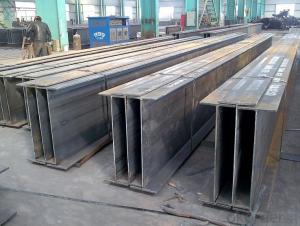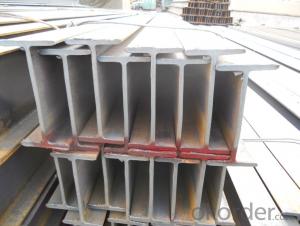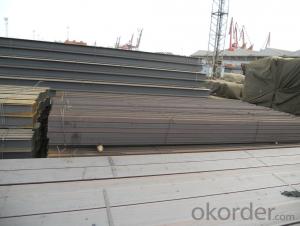Japanese Standard SS400 H beam with High Quality 400mm-428mm
- Loading Port:
- Tianjin
- Payment Terms:
- TT OR LC
- Min Order Qty:
- 100 m.t
- Supply Capability:
- 15000 m.t/month
OKorder Service Pledge
OKorder Financial Service
You Might Also Like
Item specifice
Specifications of Japanese Standard SS400 H beam with High Quality 400mm-428mm:
1. Standard: JIS 3192
2. Grade: SS400 or Equivalent
3. Length: 10m, 12m as following table
4. Invoicing on theoretical weight or actual weight as customer request
5.Payment: TT or L/C
Size and Mass of Japanese Standard SS400 H beam with High Quality 400mm-428mm:
| Size(mm) | Mass (Kg/m) | Size (mm) | Mass (Kg/m) |
| 400*400*13.0 | 172 | 414*405*18.0 | 232 |
| 400*408*21.0 | 197 | 428*407*20.0 | 283 |
Packaging & Delivery of Japanese Standard SS400 H beam with High Quality 400mm-428mm for Building Structures:
1. Packing: it is nude packed in bundles by steel wire rod
2. Bundle weight: not more than 3.5MT for bulk vessel; less than 3 MT for container load
3. Marks:
Color marking: There will be color marking on both end of the bundle for the cargo delivered by bulk vessel. That makes it easily to distinguish at the destination port.
Tag mark: there will be tag mark tied up on the bundles. The information usually including supplier logo and name, product name, made in China, shipping marks and other information request by the customer.
If loading by container the marking is not needed, but we will prepare it as customer request.
4. Transportation: the goods are delivered by truck from mill to loading port, the maximum quantity can be loaded is around 40MTs by each truck. If the order quantity cannot reach the full truck loaded, the transportation cost per ton will be little higher than full load.
5. Delivered by container or bulk vessel.
FAQ:
Q1: Why buy Materials & Equipment from OKorder.com?
A1: All products offered by OKorder.com are carefully selected from China's most reliable manufacturing enterprises. Through its ISO certifications, OKorder.com adheres to the highest standards and a commitment to supply chain safety and customer satisfaction.
Q2: How do we guarantee the quality of our products?
A2: We have established an advanced quality management system which conducts strict quality tests at every step, from raw materials to the final product. At the same time, we provide extensive follow-up service assurances as required.
Q3: How soon can we receive the product after purchase?
A3: Within three days of placing an order, we will arrange production. The shipping date is dependent upon the quatity, how many sizes you want and the plan of production, but is typically 1 month to 2 months from the beginning of production.
Images of Japanese Standard SS400 H beam with High Quality 400mm-428mm:


* If you would like to get our price, please inform us the size, standard/material and quantity. Thank you very much for your attention.
- Q:What is the maximum length of a steel H-beam that can be manufactured?
- The maximum length of a steel H-beam that can be made depends on various factors, including the manufacturing process, transportation limitations, and practical constraints. Concerning the manufacturing process, steel H-beams are typically produced in set lengths, which can vary depending on the specific steel mill or manufacturer. These standard lengths typically range from 20 to 60 feet (6 to 18 meters). However, it is worth noting that longer lengths can often be requested or fabricated based on specific project requirements. Transportation restrictions also play a significant role in determining the maximum length of a steel H-beam. The beam's length must be able to fit within the constraints of transportation methods such as trucks, trains, or ships. Each of these transportation methods has its own size limitations, and going beyond these limits may necessitate special arrangements, permits, or even partial disassembly of the beam. Lastly, practical limitations must be considered when determining the maximum length of a steel H-beam. Lengthier beams can pose challenges in terms of handling, maneuvering, and installation at construction sites. The weight and size of the beam can make transportation and lifting more difficult, potentially requiring specialized equipment or additional manpower. In conclusion, while there are standard lengths for steel H-beams, the maximum length that can be manufactured is influenced by the manufacturing process, transportation restrictions, and practical considerations. Custom orders, transportation logistics, and practical limitations all contribute to determining the maximum length of a steel H-beam.
- Q:What are the thermal conductivity properties of steel H-beams?
- Steel H-beams exhibit a relatively high level of thermal conductivity. Thermal conductivity refers to a material's capacity to transfer heat. Compared to materials like wood or plastics, steel demonstrates superior thermal conductivity due to its ability to conduct heat effectively. The precise thermal conductivity of steel H-beams may differ depending on the specific alloy and composition of the steel utilized. Nevertheless, on average, steel exhibits a thermal conductivity range of 15 to 50 W/m·K (watts per meter kelvin). Consequently, steel H-beams excel in facilitating heat transfer and are capable of rapidly distributing thermal energy throughout their structure. The exceptional thermal conductivity of steel H-beams renders them suitable for diverse applications within the fields of construction and engineering. For instance, when employed in buildings, steel H-beams can aid in the dissipation of heat and the prevention of hot spots. Moreover, they can be utilized in heat transfer systems such as heat exchangers, where efficient heat transfer is paramount. In summary, steel H-beams possess commendable thermal conductivity properties, enabling them to conduct and distribute heat efficiently.
- Q:Are steel H-beams resistant to water or moisture damage?
- Steel H-beams are highly resistant to water and moisture damage. Unlike wood or other organic materials, steel does not absorb water or moisture. This characteristic prevents steel H-beams from rotting, warping, or deteriorating when exposed to water or moisture. Moreover, steel is also resistant to the growth of mold and mildew, making it even more durable in wet or humid environments. Some steel H-beams are coated with galvanized protection to further prevent corrosion caused by moisture exposure. However, it is important to note that while the steel H-beams themselves are resistant to water or moisture damage, the connections or joints between the beams may corrode if precautions are not taken. Therefore, regular maintenance and inspections are necessary to ensure the long-term integrity and performance of steel H-beams in wet or humid conditions.
- Q:How do you calculate the section modulus of steel H-beams?
- To calculate the section modulus of steel H-beams, you need to determine the moment of inertia of the cross-sectional area of the beam and divide it by the distance from the neutral axis to the outermost fiber. The formula for section modulus is Z = I / c, where Z is the section modulus, I is the moment of inertia, and c is the distance from the neutral axis to the outermost fiber.
- Q:How do steel H-beams perform in extreme weather conditions?
- Steel H-beams are renowned for their exceptional strength and durability, making them applicable to a wide range of uses, including construction and engineering projects. However, it is vital to consider the performance of steel H-beams in extreme weather conditions. In general, steel exhibits a high level of resistance to adverse weather conditions, such as extreme heat, cold, rain, and wind. Specifically, H-beams are engineered to withstand heavy loads and provide structural support, indicating their capability to endure harsh weather conditions. One significant advantage of steel H-beams in extreme weather conditions lies in their resistance to corrosion. Steel possesses inherent resistance to rust and deterioration, and additional protective coatings can further enhance its resistance. Consequently, steel H-beams remain a dependable choice even in environments with high humidity or exposure to saltwater. Under extreme heat, steel H-beams possess a high melting point and can endure elevated temperatures without compromising their structural integrity. This quality renders them suitable for regions prone to wildfires or intense heatwaves. Similarly, in cold weather conditions, steel H-beams retain their strength and stability without becoming brittle or losing their load-bearing capacity. Consequently, they ensure the structural integrity of buildings and infrastructure even in freezing temperatures. Steel H-beams also exhibit favorable performance in extreme wind conditions. Their sturdy construction and effective load distribution make them resistant to strong winds, minimizing the risk of structural damage during storms or hurricanes. Nevertheless, it is crucial to recognize that extreme weather conditions can affect structures differently, necessitating additional precautions based on specific circumstances. Factors such as design, material quality, and proper maintenance play pivotal roles in ensuring the performance of steel H-beams in extreme weather conditions. Overall, steel H-beams generally excel in extreme weather conditions due to their strength, durability, and corrosion resistance. Nonetheless, it is always advisable to consult structural engineers and adhere to appropriate guidelines to guarantee the safety and longevity of structures in such conditions.
- Q:How long do steel H-beams typically last?
- The longevity of steel H-beams can vary depending on several factors, including the quality of the steel, the installation environment, and the level of maintenance. Typically, these beams can endure heavy loads and provide reliable structural support, making them resistant to wear and tear. By ensuring proper installation and regular upkeep, steel H-beams can remain functional for anywhere between 50 and 100 years. However, it is important to consider factors such as corrosion, exposure to severe weather, and excessive load-bearing that can impact their lifespan. Regular inspections, repairs, and preventive measures are crucial for extending the lifespan of steel H-beams and maintaining their structural integrity in the long run.
- Q:How are steel H-beams installed on construction sites?
- Steel H-beams are commonly used in construction sites for their strength and durability. The installation process of these beams involves several steps to ensure their proper placement and stability. Firstly, the construction site must be prepared for the installation of the steel H-beams. This includes clearing the area of any debris, leveling the ground, and ensuring that the foundation is strong enough to support the weight of the beams. Once the site is prepared, the beams are typically delivered to the construction site in sections. These sections are then lifted into position using cranes or other heavy machinery. The beams are carefully aligned and placed on temporary supports, known as cribbing, to hold them in place during the installation process. Next, the beams are bolted together at the connection points. This ensures that they form a solid and secure structure. Welding may also be used to reinforce the connections and increase their strength. After the beams are connected, they are adjusted into the desired position using hydraulic jacks or other lifting equipment. This ensures that the beams are level and properly aligned with the rest of the structure. Once the beams are in their final position, they are permanently secured to the foundation or supporting structure using bolts or welding. This ensures that they are stable and will not shift or move over time. Finally, the temporary supports, or cribbing, can be removed once the beams are securely in place. This allows for the completion of other construction tasks, such as the installation of flooring or walls. Overall, the installation of steel H-beams on construction sites requires careful planning, coordination, and the use of appropriate machinery. It is important to follow industry guidelines and standards to ensure the structural integrity and safety of the building.
- Q:Can Steel H-Beams be used in marine or waterfront construction?
- Yes, steel H-beams can be used in marine or waterfront construction. Steel H-beams are commonly used in various construction projects due to their strength, durability, and versatility. They have a high load-bearing capacity, making them suitable for supporting heavy structures and resisting the forces exerted by water or waves. In marine or waterfront construction, steel H-beams can be used for various applications such as constructing piers, docks, bridges, seawalls, and other waterfront structures. The steel material is corrosion-resistant, which is important in a marine environment where exposure to saltwater and moisture can cause rapid deterioration of other materials. Additionally, steel H-beams can be easily fabricated, allowing for customized designs and precise construction. Overall, steel H-beams are a reliable choice for marine or waterfront construction due to their strength, durability, corrosion resistance, and adaptability to various construction needs.
- Q:How do steel H-beams withstand extreme weather conditions?
- Steel H-beams are designed to withstand extreme weather conditions due to their inherent strength and durability. The construction of H-beams involves the use of high-quality steel alloys, such as carbon steel or stainless steel, which provide excellent resistance to various weather elements. Firstly, steel H-beams have a high tensile strength, which means they can resist heavy loads and external forces. This strength allows them to withstand strong wind forces, heavy snow loads, and even earthquakes. Additionally, their unique H-shape design provides increased stability and structural integrity, making them more resistant to bending or buckling under extreme weather conditions. Furthermore, steel H-beams are often coated or galvanized to protect them from corrosion and rusting caused by moisture or chemicals present in the atmosphere. The coating acts as a barrier, preventing water or other damaging substances from penetrating the steel surface. This protective layer enhances the beams' longevity and ensures their ability to withstand harsh weather conditions over an extended period. Moreover, steel is an excellent conductor of heat, which means it can effectively dissipate heat generated by extreme temperatures. This property prevents the beams from expanding or contracting excessively, reducing the risk of structural damage. Steel H-beams can withstand both extreme heat and cold, making them suitable for use in areas with high temperature variations or severe weather conditions. In conclusion, steel H-beams are designed to withstand extreme weather conditions through their high tensile strength, stability, corrosion resistance, and ability to dissipate heat effectively. These factors make them a reliable choice for various construction projects, ensuring the integrity and safety of structures even in the harshest weather environments.
- Q:What are the considerations for designing with steel H-beams?
- When designing with steel H-beams, there are several important considerations to keep in mind. First and foremost, it is essential to understand the load-bearing capacity of the H-beams. This includes determining the maximum weight that the beams can support and ensuring that the design factors in any potential dynamic or live loads that may be applied. Calculating the required strength of the beams can be done through structural analysis and design calculations, taking into account factors such as the span length, beam size, and material properties. Another consideration is the overall structural stability and rigidity of the H-beam design. H-beams are known for their high strength-to-weight ratio, but they can also be susceptible to lateral torsional buckling under certain conditions. It is important to analyze and design for these potential stability issues to ensure the safety and integrity of the structure. This may involve adding additional bracing or stiffeners to the H-beams to enhance their stability. Connection detailing is also a crucial aspect of designing with steel H-beams. The connections between the H-beams and other structural members, such as columns or beams, need to be carefully designed to ensure proper load transfer and structural continuity. The type of connection, whether it be bolted, welded, or a combination of both, should be selected based on factors such as the expected loads, construction constraints, and the desired level of structural flexibility. Fire resistance is another consideration when designing with steel H-beams. Steel is inherently fire-resistant, but it can lose its strength and stiffness when subjected to high temperatures for extended periods. Therefore, it is important to consider fire protection measures, such as fireproof coatings or the use of fire-resistant materials, to ensure the structural integrity of the H-beams in the event of a fire. Lastly, the cost and availability of steel H-beams should be taken into account during the design process. The size, grade, and quantity of H-beams required for the project may have an impact on the overall cost and feasibility of the design. Additionally, it is important to consider the availability of the required H-beams in the market to avoid potential delays or cost overruns. In conclusion, designing with steel H-beams requires careful consideration of load-bearing capacity, structural stability, connection detailing, fire resistance, and cost considerations. By addressing these factors, a well-designed H-beam structure can be achieved that meets the required performance criteria and ensures the safety and durability of the project.
1. Manufacturer Overview |
|
|---|---|
| Location | |
| Year Established | |
| Annual Output Value | |
| Main Markets | |
| Company Certifications | |
2. Manufacturer Certificates |
|
|---|---|
| a) Certification Name | |
| Range | |
| Reference | |
| Validity Period | |
3. Manufacturer Capability |
|
|---|---|
| a)Trade Capacity | |
| Nearest Port | |
| Export Percentage | |
| No.of Employees in Trade Department | |
| Language Spoken: | |
| b)Factory Information | |
| Factory Size: | |
| No. of Production Lines | |
| Contract Manufacturing | |
| Product Price Range | |
Send your message to us
Japanese Standard SS400 H beam with High Quality 400mm-428mm
- Loading Port:
- Tianjin
- Payment Terms:
- TT OR LC
- Min Order Qty:
- 100 m.t
- Supply Capability:
- 15000 m.t/month
OKorder Service Pledge
OKorder Financial Service
Similar products
New products
Hot products
Related keywords



























